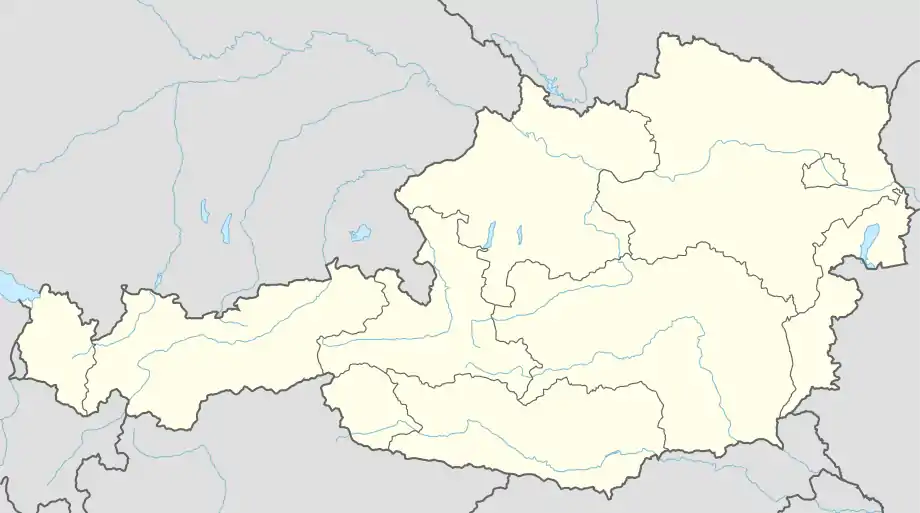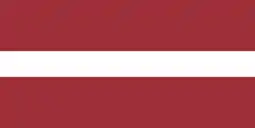Judenburg
It is the administrative centre of the Murtal district, which was created on 1 January 2012 from the former Judenburg District and former Knittelfeld District. Until 31 December 2011, it was the capital of the Judenburg District.
Judenburg | |
|---|---|
 View from southwest | |
 Coat of arms | |
 Judenburg Location within Austria | |
| Coordinates: 47°10′21″N 14°39′37″E | |
| Country | Austria |
| State | Styria |
| District | Murtal |
| Government | |
| • Mayor | Hannes Dolleschall (SPÖ) |
| Area | |
| • Total | 63.69 km2 (24.59 sq mi) |
| Elevation | 737 m (2,418 ft) |
| Population (2018-01-01)[2] | |
| • Total | 9,960 |
| • Density | 160/km2 (410/sq mi) |
| Time zone | UTC+1 (CET) |
| • Summer (DST) | UTC+2 (CEST) |
| Postal code | 8750 |
| Area code | 03572 |
| Vehicle registration | MT |
| Website | www |
Judenburg is a historic town in Styria, Austria.
On 1 January 2015, the adjoining municipalities of Oberweg and Reifling were merged into Judenburg.
Geography
It is located in the Upper Styrian region, on the western end of the Aichfeld basin, stretching along the Mur River from Judenburg down to Knittelfeld in the east. The broad valley is bound by the Niedere Tauern range in the north and the Noric Alps (Lavanttal Alps) in the south.
The municipal area also comprises the cadastral communities of Tiefenbach and Waltersdorf, a former municipality incorporated in 1963.
The municipal area includes the following ten villages (Population 01-01-2020):
- Auerling (129)
- Feeberg (176)
- Gasselsdorf (28)
- Judenburg (8386)
- Oberweg (517)
- Ossach (45)
- Reifling (57)
- Ritzersdorf (15)
- Strettweg (367)
- Waltersdorf (133)
History

Archaeological findings indicate that the area was settled at least since the days of the Celtic kingdom of Noricum. Judenburg itself was first mentioned in a 1074 staple right deed as mercatum Judinburch, a market town within the estates of Eppenstein Castle, the ancestral seat of the Bavarian Eppensteiner noble family, who ruled as Styrian margraves in the 11th century. The name literally means "Jews' Borough", referring to the town's origin as a trading outpost on the route from the Mur Valley across the Obdach Saddle mountain pass to Carinthia, in which Jews played an important role, being represented in the city's coat of arms.
Upon the extinction of the Eppensteiner dynasty in 1122, the estates passed to the Styrian Otakars and in 1192 to the House of Babenberg, Dukes of Austria since 1156. Judenburg received town privileges in 1224 and the right to collect tolls in 1277. The town grew to an important commercial centre for iron ore mined at nearby Eisenerz, but also for valeriana celtica used in perfumes during the 13th and 14th century. Judenburg was even granted a valeriana trade monopoly by the Habsburg emperor Frederick III in 1460. After several pogroms, all Jews were expelled from the Duchy of Styria by order of Emperor Maximilian I in 1496. Following his breakthrough in Italy, General Napoléon Bonaparte made his headquarters at Judenburg and it was there, on the night of 7–8 April 1796, that he signed the Truce of Judenburg with the Austrians.
In the beginning of the 20th century, the town was one of the centres of Austria–Hungary's steel industry and also a garrison town of the Austro-Hungarian Army. From 1910 to 1914 one of the first trolleybusses in Austria connected Judenburg station with the town's centre. Today, little remains of the former industry, but Judenburg remains an industrial and trade centre. In May 1918, the town was the site of a failed military mutiny.
In 1938, with the annexation of Austria by Nazi Germany, Judenburg became part of the Third Reich. Due to the presence of the word Jude ("Jew") in the town's name, a number of possible new names were suggested, including Zirbenstadt (after Zirbe, the German name for the Swiss pine tree) and Adolfsburg (in honour of Adolf Hitler). However, the planned renaming was indefinitely postponed after the outbreak of war and ultimately never happened.[3][4]
During the Second World War, a subcamp of Mauthausen concentration camp was located nearby,[5] where a displaced persons' reception centre was established after the war. Judenburg was also one of several towns that saw the handover of Cossacks to the Red Army.
Politics

Seats in the municipal assembly (Gemeinderat) as of 2010 elections:
- Social Democratic Party of Austria (SPÖ): 16
- Austrian People's Party (ÖVP): 5
- Communist Party of Austria (KPÖ): 2
- Freedom Party of Austria (FPÖ): 2
International relations
Twin towns - Sister cities
Judenburg is a member of the Douzelage, a unique town twinning association of 24 towns across the European Union. This active town twinning began in 1991 and there are regular events, such as a produce market from each of the other countries and festivals.[6][7] Discussions regarding membership are also in hand with three further towns (Agros in Cyprus, Škofja Loka in Slovenia, and Tryavna in Bulgaria).
 Altea, Spain - 1991
Altea, Spain - 1991 Bad Kötzting, Germany - 1991
Bad Kötzting, Germany - 1991 Bellagio, Italy - 1991
Bellagio, Italy - 1991 Bundoran, Ireland - 1991
Bundoran, Ireland - 1991 Granville, France - 1991
Granville, France - 1991 Holstebro, Denmark - 1991
Holstebro, Denmark - 1991.svg.png.webp) Houffalize, Belgium - 1991
Houffalize, Belgium - 1991 Meerssen, the Netherlands - 1991
Meerssen, the Netherlands - 1991 Niederanven, Luxembourg - 1991
Niederanven, Luxembourg - 1991 Preveza, Greece - 1991
Preveza, Greece - 1991 Sesimbra, Portugal - 1991
Sesimbra, Portugal - 1991 Sherborne, United Kingdom - 1991
Sherborne, United Kingdom - 1991 Karkkila, Finland - 1997
Karkkila, Finland - 1997 Oxelösund, Sweden - 1998
Oxelösund, Sweden - 1998 Judenburg, Austria - 1999
Judenburg, Austria - 1999 Chojna, Poland - 2004
Chojna, Poland - 2004 Kőszeg, Hungary - 2004
Kőszeg, Hungary - 2004 Sigulda, Latvia - 2004
Sigulda, Latvia - 2004 Sušice, Czech Republic - 2004
Sušice, Czech Republic - 2004 Türi, Estonia - 2004
Türi, Estonia - 2004 Zvolen, Slovakia - 2007
Zvolen, Slovakia - 2007 Prienai, Lithuania - 2008
Prienai, Lithuania - 2008 Marsaskala, Malta - 2009
Marsaskala, Malta - 2009 Siret, Romania - 2010
Siret, Romania - 2010
Notable people

- Harald Bosio (1906–1980), skier
- Renate Götschl (born 1975), skier
- Gernot Jurtin (1955–2006), football player
- Vinzenz Kaiser (1904-1945), SS-officer
- Thomas Krammer (born 1983), football player
- Michael Madl (born 1988), football player
- Christian Muthspiel (born 1962), jazz musician
- Wolfgang Muthspiel (born 1965), jazz musician
- Christian Pfannberger (born 1979), racing cyclist
- Walter Pfrimer (1881–1968), politician and Nazi, known for the 1931 Pfrimer Putsch
- Alf Poier (born 1967), singer-songwriter and comedian
- Herfried Sabitzer (born 1969), football player
- Gernot Sick (born 1978), football player
- Christoph Sumann (born 1976), biathlete
- Jack Unterweger (1950–1994), author and serial killer
- Andreas Zuber (born 1983), racing driver
References
- "Dauersiedlungsraum der Gemeinden Politischen Bezirke und Bundesländer - Gebietsstand 1.1.2018". Statistics Austria. Retrieved 10 March 2019.
- "Einwohnerzahl 1.1.2018 nach Gemeinden mit Status, Gebietsstand 1.1.2018". Statistics Austria. Retrieved 9 March 2019.
- Vgl. Michael Schiestl: „Zirbitz-“, „Adolf-“ oder „Jubelburg“. Dokumente des „gesunden Volksempfindens“. In: Berichte des Museumsvereines Judenburg. 33 (2000), S. 23–32.
- Strunz, Gunnar: Steiermark: Das grüne Herz Österreichs, p. 130. (link)
- Christine O’Keefe.Concentration Camps.
- "Douzelage.org: Home". www.douzelage.org. Archived from the original on 2010-02-17. Retrieved 2009-10-21.
- "Douzelage.org: Member Towns". www.douzelage.org. Archived from the original on 2009-04-06. Retrieved 2009-10-21.
External links
| Wikimedia Commons has media related to Judenburg. |